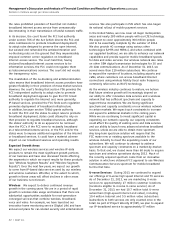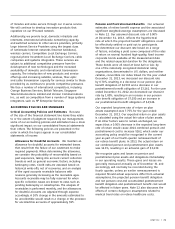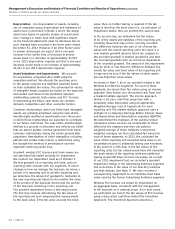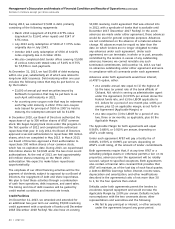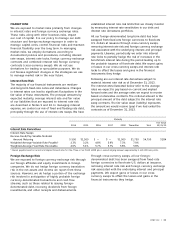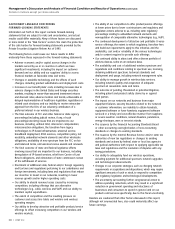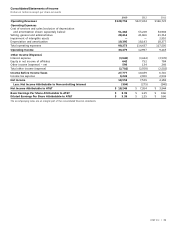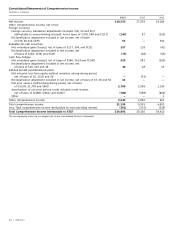AT&T Wireless 2013 Annual Report Download - page 34
Download and view the complete annual report
Please find page 34 of the 2013 AT&T Wireless annual report below. You can navigate through the pages in the report by either clicking on the pages listed below, or by using the keyword search tool below to find specific information within the annual report.
Management’s Discussion and Analysis of Financial Condition and Results of Operations (continued)
Dollars in millions except per share amounts
32 | AT&T Inc.
Contractual Obligations
Payments Due By Period
Less than 1-3 3-5 More than
Total 1 Year Years Years 5 Years
Long-term debt obligations1 $ 75,500 $ 5,472 $ 13,181 $ 11,057 $ 45,790
Interest payments on long-term debt 53,219 3,350 6,035 5,328 38,506
Finance obligations2 3,945 221 454 473 2,797
Operating lease obligations 24,952 3,003 5,551 4,691 11,707
Unrecognized tax benefits3 2,332 265 — — 2,067
Purchase obligations4 14,320 5,749 5,182 2,570 819
Total Contractual Obligations $174,268 $ 18,060 $ 30,403 $ 24,119 $101,686
1 Represents principal or payoff amounts of notes and debentures at maturity or, for putable debt, the next put opportunity.
2 Represents future minimum payments under the sublease arrangement for our tower transactions (see Note 16).
3 The noncurrent portion of the UTBs is included in the “More than 5 Years” column, as we cannot reasonably estimate the timing or amounts of additional cash payments, if
any, at this time. See Note 11 for additional information.
4 We calculated the minimum obligation for certain agreements to purchase goods or services based on termination fees that can be paid to exit the contract. If we elect to
exit these contracts, termination fees for all such contracts in the year of termination could be approximately $489 in 2014, $567 in the aggregate for 2015 and 2016, $174
in the aggregate for 2017 and 2018, and $8 in the aggregate thereafter. Certain termination fees are excluded from the above table, as the fees would not be paid every
year and the timing of such payments, if any, is uncertain.
that the commitments will have a material effect on our
financial condition, results of operations or cash flows.
Our contractual obligations as of December 31, 2013,
are in the following table. The purchase obligations that
follow are those for which we have guaranteed funds and
will be funded with cash provided by operations or through
incremental borrowings. The minimum commitment for
certain obligations is based on termination penalties
that could be paid to exit the contract. Other long-term
liabilities are included in the table based on the year of
required payment or an estimate of the year of payment.
Such estimate of payment is based on a review of past
trends for these items, as well as a forecast of future
activities. Certain items were excluded from the following
table, as the year of payment is unknown and could
not be reliably estimated since past trends were not
deemed to be an indicator of future payment.
Substantially all of our purchase obligations are in our
Wireline and Wireless segments. The table does not
include the fair value of our interest rate swaps. Our capital
lease obligations and bank borrowings have been excluded
from the table due to the insignificant amounts of such
obligations at December 31, 2013. Many of our other
noncurrent liabilities have been excluded from the
following table due to the uncertainty of the timing of
payments, combined with the absence of historical trending
to be used as a predictor of such payments. Additionally,
certain other long-term liabilities have been excluded
since settlement of such liabilities will not require the
use of cash. However, we have included, in the following
table, obligations that primarily relate to benefit funding
due to the certainty of the timing of these future payments.
Our other long-term liabilities are: deferred income
taxes (see Note 11) of $36,308; postemployment benefit
obligations of $29,946; and other noncurrent liabilities
of $15,766.
that of AT&T, (2) the date on which AT&T is rated below
investment grade for two consecutive calendar quarters,
(3) upon a change of control if AT&T does not exercise
its purchase option, or (4) at any time after a seven-year
period from the contribution date. In the event AT&T elects
or is required to purchase the preferred equity interest,
AT&T may elect to settle the purchase price in cash or
shares of AT&T common stock or a combination thereof.
On September 9, 2013, the Department of Labor (DOL)
published a proposed exemption that authorizes retroactive
approval of this voluntary contribution. The proposal was
open for public comment and we are currently awaiting a
final decision by the DOL. Our retirement benefit plans,
including required contributions, are subject to the
provisions of ERISA.
CONTRACTUAL OBLIGATIONS,
COMMITMENTS AND CONTINGENCIES
Current accounting standards require us to disclose our
material obligations and commitments to making future
payments under contracts, such as debt and lease
agreements, and under contingent commitments, such as
debt guarantees. We occasionally enter into third-party
debt guarantees, but they are not, nor are they reasonably
likely to become, material. We disclose our contractual
long-term debt repayment obligations in Note 9 and
our operating lease payments in Note 6. Our contractual
obligations do not include contributions associated with
our voluntary contribution of the Mobility preferred equity
interest, or expected pension and postretirement payments
(we maintain pension funds and Voluntary Employee
Beneficiary Association trusts to fully or partially fund these
benefits) (see Note 12). In the ordinary course of business,
we routinely enter into commercial commitments for
various aspects of our operations, such as plant additions,
inventory and office supplies. However, we do not believe


